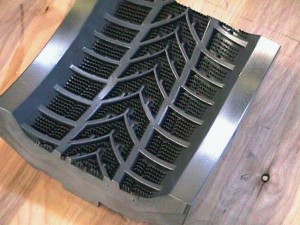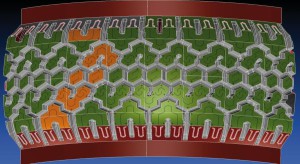The engineer, our interviewee, has established the Engineering Equipment & Tread Mold Design to reap the fruits of twenty years of experience exclusively in the engineering of complex treads for high-end tires and in the design of the necessary moulds for their implementation. Paving the way to 3D printing, too.

Stefano Palma, in the middle of the photo, with his sons Gabriele and Andrea, founders of Engineering Equipment & Tread Mold Design in Barletta.
Stefano Palma was a learner of Donato Pasquale, the engineer father of “fresadue”, and he still works in a complex niche sector: the design of treads and of the moulds needed to produce tires, with special focus on high-end products where engineering complexities are more relevant, thus highlighting the competences gained in two decades of activity in this field. The history of his adventure on his own started two years ago when, together with his sons, he decided to set up Engineering Equipment & Tread Mold Design headquartered in Barletta. A design studio with very high specialization, since it exclusively works at the implementation of the three-dimensional model of tires of all kinds, from OTR models (off the road, for agricultural and off-road vehicles in general) up to those defined passenger for cars, purposely studied for high-end cars.
They are 3D designs involving a very complex implementation, where the engineering, study, safety and braking performances are already part of a word carefully studied by expert teams coming from both the companies purchasing models from Engineering Equipment & Tread Mold Design and from technicians of Barletta compan2y, whose team is currently formed by six people that operate inside and by two experts that work in Germany and Belgium, thus forming a sort of mobile technical office in constant contact through Internet instruments. On the other hand, we cannot state that the activity of Engineering Equipment & Tread Mold Design is precisely linked with the territory, since its customers are exclusively foreign and spread all over the world. Besides designing and engineering complex treads for high-end tires, based on the rigorous specifications identified upstream, Eng. Eq. & Tread Mold Design also takes care of designing the equipment to mould them, lavishing in this activity a good part of engineering innovation among which, worth mentioning as we will see later on, Ventless moulds. Moreover: for about one year, the technical studio of Eng. Eq. & Tread Mold Design has also been manufacturing tire moulds through 3D printing, manufacturing them in metal with the laser melting technology. We talked about the company and the design philosophy that represents its background with the founder Stefano Palma who, before starting his activity, from 1990 to 2005 was the manager of the technical department of A.M.A. Spa at Bitonto (Bari), specialized in equipment for tire moulds. A company that was compelled to shut off in 2009 owing to various economic troubles. A misfortune for Stefano Palma who, 52 years old, soon realized it is not easy to be employed by another business reality. At the same time, however, he could turn his “know how” into an “opportunity”, since the forced shut off of his former employer gave him the boost to start working on his own, providing also a prospect of solid job to his sons who are completing their studies in informatics and engineering, and to set up a studio that since the early months of activity started on the right foot and goes on developing with slow progressivity.
Can you confirm that there are not many professionalisms like yours in the ambit of tire moulds?
Yes, we can count the companies operating in this sector in Europe on the fingers of one hand. In the Bari factory of the former A.M.A. Spa we made moulds for tires for all major sector companies, from Pirelli to Vredestein. When, in 2009, the company had to close its doors, I decided to capitalize my experience by establishing Engineering Equipment & Tread Mold Design with my sons Gabriele and Andrea, to whom I transmit every day the knowledge gained in twenty years of activity in this sector.

An example of mould part on which is currently focused the experimentation of Engineering Equipment & Tread Mold Design to introduce the 3D printing through laser melting in this sector effectively. The part, fully 3D printed, was sanded and deburred with standard post-machining operations.
How is your self-employment going?
A constant growth course has led Eng. Eq. & T. M. D. to employ two engineers, Massimo Marciante and Matteo Mazzone, both relying on a long competence in the sector for a long time. Since the early phases, we started collaborating with some of the companies with which I worked through my former business, and all of them were aware of my knowledge of the complex problems connected with the design and manufacturing of tire moulds.
Knowledge that you cannot learn in a normal study course, I guess …
Yes, certainly. You need at least five/ten years to acquire the necessary competences to design high-level treads and the equipment to make them. Without considering that it is an extremely evolving field in terms of innovation and regulations, and therefore a constant theoretical, and especially on the spot, upgrading is necessary to keep pace with the fast evolutions of tread designs, demanded to satisfy the growing requirements of this sector in terms of safety, performances, compliance with international regulations and so on.
What is the workflow in an activity like yours that requires constant information exchanges with distant buyers?
Purchasers generally send us the first tread sketches, on which we work until when the design takes a definitive and approved shape. We generally carry out this work phase with simple and intuitive design software. In the second stage, the most committing from the design point of view, we proceed to the development of the three-dimensional model. Accomplished this work, we send it to the buyer’s team so that they can verify that it complies with all severe specifications initially demanded. At this stage, the core of the work has been completed and we can start with the third phase, which consists in implementing the models for the various types of rims equipping that tire. In this case, too, our designs are subjected to the analysis of the buyer, which provides for carrying out complex simulations. We use more complex parametric software for the last two design steps. Once definitively approved our 3D model, we start designing the equipment and actually manufacturing the tire. And our task ends here.
Have you considered the hypothesis of introducing the new additive printing technologies into the process, too?
Yes, we started this experimentation last year to implement part of the moulds by using 3D metal printers based on the Direct Metal Laser Sintering (DMLS). We are collaborating with a German manufacturer of 3D printing systems to achieve, by modifying the machine and powder specifications, steel and aluminium moulds with a high precision degree and good detail level. We are working at an experimental tread whose design changes according to the mileage. After the first 5000/6000 kilometres the initial design, due to wear, changes completely. After 10,000/15,000 kilometres the design changes again, all in proportion to safety.
Concerning this, what are the main difficulties you faced?
This new sector, where we are concentrating our efforts, is subjecting our company to a dynamics of changes, whose interpretation calls for relevant skills and great intuitiveness. We have noticed that the density of a mould produced with additive manufacturing is lower than the one created with standard techniques, but its mechanical properties exceed moulds implemented by melting. Until one year ago, a mould manufactured through laser sintering where “to cook” a tire lasted some weeks and this is obviously unacceptable. Our activity on this aspect, which mainly focused on the powder mixture to extend the mould life, is giving encouraging results. The implementation times of a mould have decreased, too, to full advantage, for instance, of tire manufacturers that want to see and to test tires with state-of-the-art treads in short times.
In what cases is it convenient to adopt the additive technology instead of the conventional one?
Certainly, the 3D printing is not suitable for low-end tires, like those of utility cars, for instance. Technology is constantly evolving in this field. We are working with additive technologies on high-end products, with very complex treads (we call them mangy) whose moulds would need a long implementation time by means of five-axis NC milling machines and anyway assembling various parts. 3D printing has brought into play again the insert technology often used in the Nineties and gradually given up with the advent of 5-axis milling machines.
Is the 3D printing ambit the only one where you are experimenting and researching?
No, we strongly believe in innovation and research. We take care of all that concerns tire moulds until when they reach the press. Another of the aspects on which we focus our research concerns also the implementation of moulds that use the Ventless technology for the tread modelling. I strongly believe in the so called generative” engineering, unlike the “replicative” one that today does not represent a real competitive advantage in Europe.
In what does this technology consist?
If you observe a new tire, very frequently you can notice some threadlike protrusions that come out from the tread. In a standard mould, the air input by vulcanization must exit through hundreds of small holes, from which comes out also some rubber that forms the so-called curls, too, needing a certain quantity of post-production work by operators. With Ventless moulds, which I propose to my customers, you can obtain directly from the press tires with a better aesthetical impact, without needing further machining operations.
What role does quality play inside a technical office like yours?
The “quality system” of a technical office like ours is very important for us. Over these years, I worked to make the whole staff of the technical office aware of that, aiming at obtaining a constant qualitative improvement of the product (designs and programmes) to avoid errors, oversights and so on, in order to reduce costs and to provide a qualitatively satisfactory product. The quality policy, which I strongly pursued, enabled us to accomplish all those actions leading Eng. Eq. & T.M.D. to a high competitiveness level, especially in filing and confidentiality ambits. It is what companies essentially ask for.
What is your philosophy, your design method, and how have they changed in the course of your professional activity years, first as employee and then as owner?
What previously expressed clearly points out that our reality, as technical office, addresses the tire manufacturers that want reliability and low prices. Reliability, however, is synonym of design experience with strong integration with customers’ engineers. We have always kept the technical office/customer relationship alive personally visiting the market. With the advantage that my group makes cohesion and team work the highest expressions of its organizational skills. When I worked as employee, it was not precisely like that.
What suggestion would you like to give to a young undertaking the industrial engineer carrier?
Relying on solid mathematical bases. To be “dramatically” curious. Besides, in a context like the current one, we must be the best. How many people are so ambitious as to believe in a vision? We are living a period of strong changes that will last still for a long time. It is necessary we are able to choose the role we want to play. Because the future is already the past.




